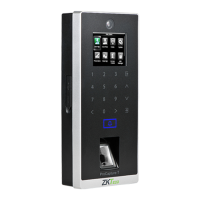50 ProCapture-T & PRoRF-T User Manual
16.2 Wiegand Introduction
Wiegand26 Protocol is a standard protocol on access control developed by the Access Control Standard
Subcommittee affiliated to the Security Industry Association (SIA). It is a protocol used for contactless IC
card reader port and output.
The protocol defines the port between the card reader and controller which are widely used in access
control, security and other related industries. This has standardized the work of card reader designers and
controller manufacturers. The access control devices produced by our company also apply this protocol.
Digital Signal
Figure 1 shows the sequence diagram of the card reader sending digital signal in bits to the access
controller. The Wiegand in this diagram follows the SIA access control standard protocol, which targets at
26-bit Wiegand card reader (with a pulse time within 20us to 100us and pulse hopping time within 200
us and 20 ms). Data1 and Data0 signals are high level (greater than Voh) until the card reader is ready to
send a data stream. The card reader send out asynchronous low level pulse (less than vol), transmitting
data stream via Data1 or Data0 wire to access control box (as the sawtooth wave in figure 1). Data1 and
Data0 pulses do not overlap or synchronize. Figure 1 shows the maximum and minimum pulse width
(successive pulses) and pulse hopping time (the time between two pulses) allowed by the F series
fingerprint access control terminals.
Table1: Pulse Time
Sign Definition Card Reader Typical Value
Tpw Pulse Width 100 µs
Tpi Pulse Interval 1 ms
Figure1: Sequence Diagram

